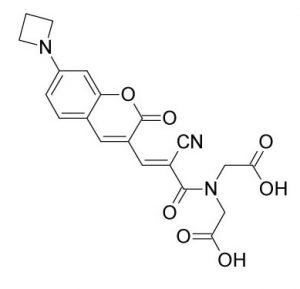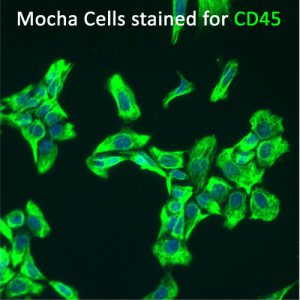10 unique reagents that helped advance research in 2017
At Kerafast, our mission is to facilitate access to unique reagents developed by academic researchers. Together with our providing investigators, we get one-of-a-kind bioreagents into the hands of scientists worldwide who can use the materials to accelerate their own research.
As we begin the new year, we took the opportunity to review how reagents in our catalog helped contribute to scientific progress in 2017. Here are 10 unique materials used in peer-reviewed research last year to further understanding of basic science and disease:
-

Glutathione (GSH) probe developed in 2017 by Baylor College of Medicine researchers. Learn more here.
From the laboratory of Jin Wang, PhD, Baylor College of Medicine
In July 2017, Dr. Jin Wang co-authored a paper in Nature Communications describing the development of easy-to-use fluorescent probes able to quantitatively monitor real-time glutathione (GSH) levels in live mammalian cells using confocal microscopy and FACS. Three of these probes are now available via the Kerafast website, where they have since been ordered and used by scientists in six countries across three continents. For more on the probes, check out a Baylor College of Medicine news article.
From the laboratory of Mark Howarth, PhD, University of Oxford
The SpyTag/SpyCatcher reagents offer a convenient protein coupling tool for irreversible peptide-protein ligation, ideal for binding, labeling, immobilization and creating new kinds of protein architectures. In March 2017, providing investigator Dr. Mark Howarth and collaborators spun a company out of the University of Oxford, called SpyBiotech, which is using the SpyTag/SpyCatcher technology to develop new vaccines. Learn more about the company’s efforts here.
From the laboratory of Dawen Cai, PhD, University of Michigan
These non-crossreactive polyclonal antibodies are used to detect GFP, mTFP, mCherry and/or TagRFP, in combination or singly. They are suitable for fluorescent imaging applications and capable of distinguishing between individual neurons in the brain. In April 2017, Dr. Cai co-authored a Nature Methods paper using several of these antibodies, which described the development of a simpler, cheaper method for high-resolution microscopy; learn more about that paper here. Other 2017 studies to use these antibodies were published in journals such as Oncogene, Molecular Psychiatry and Genes & Development.
From the laboratory of Thomas U. Schwartz, PhD, Massachusetts Institute of Technology
Ideal for poorly expressing proteins, this expression strain has been optimized for one-step downstream polyhistidine-tag affinity purification to yield recombinant protein of high purity. The strain was used for a variety of research applications in 2017; for example, it was cited in an Elife paper on ubiquitin regulation, as well as a Journal of Biology Chemistry paper on DNA repair.
-

New polymers made from canola oil and sulphur can remove mercury metal from soil. After reacting with mercury metal, the polymer changes color from brown to black. Learn more here.
From the laboratory of Justin M. Chalker, PhD, University of Flinders
In August 2017, Dr. Justin M. Chalker co-authored a paper in Chemistry detailing the creation and applications of polysulfide polymer mercury sorbents, which can extract mercury from fluids, soils and air. Derived from sulfur and renewable plant oils, the polymers offer an environmentally-friendly tool for mercury capture and remediation studies. Flinders University distributed a press release about the polymers, and the news was covered by websites such as Nature, Laboratory Equipment and Laboratory Focus.
From the laboratory of Stephen H. Leppla, PhD, National Institute of Allergy and Infectious Diseases/NIH
The S9.6 antibody offers high specificity and affinity for DNA-RNA hybrids; it does not cross-react with single-stranded DNA or double-stranded DNA and has proven useful in the detection of R-loops. The antibody was used in various 2017 studies, including a paper in Cell about the identification and repair of critically short telomeres; learn more about the research here. Other recent papers using the antibody were published in Cell Reports, Proceedings of the National Academy of Sciences (PNAS), Cancer Research and more.
From the laboratory of Paolo Serafini, PhD, University of Miami
In May 2017, Dr. Paolo Serafini co-authored a paper in the Journal of Immunology describing a new kit for the transfection of myeloid-derived suppressor cells (MDSCs) and macrophages (Mφ). Now available via the Kerafast website, the kit offers a simple procedure for delivering nucleic acids, small molecules or drugs in vivo, as well as following the fate of transfected cells by flow cytometry. The paper was highlighted in the Journal of Immunology’s “In this Issue” feature; check it out here for a summary of how the kit was used to silence tumor-educated myeloid cells.
From the laboratory of James H. Morrissey, PhD, University of Michigan
The Kerafast catalog includes four linear polymers of inorganic orthophosphate, available biotinylated and in different sizes. In 2017, the Morrissey lab continued to show how these polyphosphate chains are potent modulators of the human blood clotting system, publishing an article in the Journal of Biological Chemistry and presenting on the topic at the American Society of Hematology annual meeting in December.
-

New microglial cell line developed in 2017 by University at Buffalo researchers. Learn more here.
From the laboratory of Gail M. Seigel, PhD, University at Buffalo
In December 2017, Dr. Gail M. Seigel co-authored a paper in Molecular and Cellular Neuroscience describing the creation and characterization of a new microglial cell line (called Mocha) derived from rat cochlea, the auditory portion of the inner ear. Now available via our website, the cell line has demonstrated various microglial markers and functions; learn more from a blog post or Dr. Seigel’s five-minute audio presentation. Other microglial cell lines used for research in 2017 include the SIM-A9 cell line from the University of North Dakota and the IMG cell line from Harvard University.
From the laboratory of Thomas M. Moran, PhD, Icahn School of Medicine at Mount Sinai
The Kerafast catalog includes a variety of influenza antibodies for detecting different influenza proteins, including hemagglutination, neuraminidase and more. Dr. Moran’s nucleoprotein antibody was used in a January 2017 Nature study to explore how the flu virus is able to hijack host cell RNA; learn more about that research in a blog post here. Later in the year, the same antibody was cited in a Nature Communications paper on influenza virus genome transport.
If you used any of our reagents to advance your research in 2017, be sure to let us know! Email info@kerafast.com with your peer-reviewed article citing a Kerafast reagent, and we’ll provide a one-time 50% off coupon code for your next reagent purchase. Best wishes for successful research in 2018!


